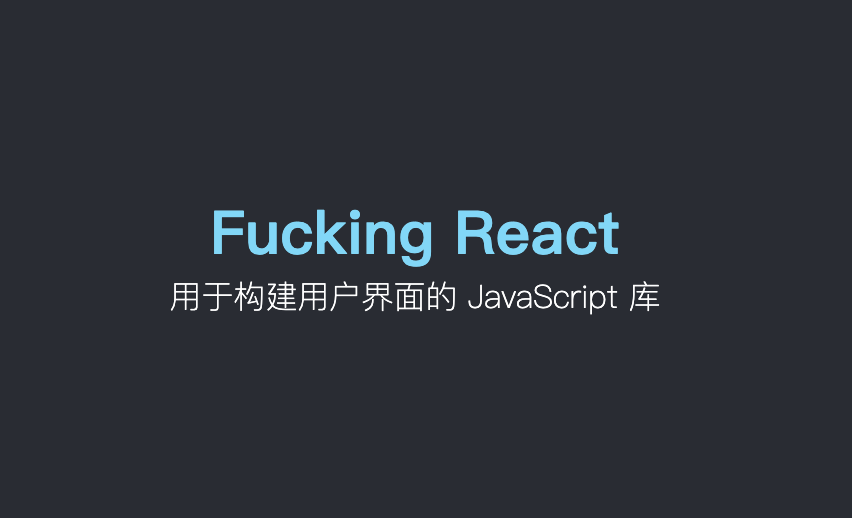从零打造“乞丐版” React(一)——从命令式编程到声明式编程
这个系列的目的是通过使用 JS 实现“乞丐版”的 React,让读者了解 React 的基本工作原理,体会 React 带来的构建应用的优势
1 HTML 构建静态页面

使用 HTML 和 CSS,我们很容易可以构建出上图中的页面
<!DOCTYPE html><html lang="en"><head><title>Build my react</title><style>div {text-align: center;}.father {display: flex;flex-direction: column;justify-content: center;height: 500px;background-color: #282c34;font-size: 30px;font-weight: 700;color: #61dafb;}.child {color: #fff;font-size: 16px;font-weight: 200;}</style></head><body><div class="father">Fucking React<div class="child">用于构建用户界面的 JavaScript 库</div></div></body></html>
当然这只是一个静态的页面,我们知道,网站中最重要的活动之一是和用户产生交互,用户通过触发事件来让网页产生变化,这时就需要用到 JS
2 DOM 构建页面
使用 DOM 操作,我们也可以构建上面的静态页面,并且可以动态地改变页面、添加事件监听等来让网页活动变得更加丰富
我们先改写一下 HTML 的 body(如果没有特殊说明,本文不会更改 CSS 的内容),我们将 body 中的内容都去掉,新增一个 id 为 root 都 div 标签,并且引入index.js。
<div id="root"></div><script src="./index.js"></script>
index.js内容如下:
const text = document.createTextNode("Fucking React");const childText = document.createTextNode("用于构建用户界面的 JavaScript 库");const child = document.createElement("div");child.className = "child";child.appendChild(childText);const father = document.createElement("div");father.className = "father";father.appendChild(text);father.appendChild(child);const container = document.getElementById("root");container.appendChild(father);
使用 DOM 操作,我们也可以构建出同样的页面内容,但是缺点很明显
<div class="father">Fucking React<div class="child">用于构建用户界面的 JavaScript 库</div></div>
原本只要寥寥几行 HTML 的页面。使用 DOM 之后,为了描述元素的嵌套关系、属性、内容等,代码量骤增,并且可读性非常差。这就是命令式编程,我们需要一步一步地指挥计算机去做事
这还只是一个简单的静态页面,没有任何交互,试想一下,如果一个非常复杂的网页都是用 DOM 来构建,不好意思,我不想努力了~
3 从命令式到声明式
观察上述 index.js,我们不难发现,在创建每个节点的时候其实可以抽象出一组重复操作:
- 根据类型创建元素
- 添加元素属性(如 className)
- 逐一添加子元素
对于元素的嵌套关系和自身属性,我们可以利用对象来描述
const appElement = {type: "div",props: {className: "father",children: [{type: "TEXT",props: {nodeValue: "Fucking React",children: [],},},{type: "div",props: {className: "child",children: [{type: "TEXT",props: {nodeValue: "用于构建用户界面的 JavaScript 库",children: [],},},],},},],},};
其中,type表示元素类型,特殊地,对于字符串文本,我们用TEXT表示;props对象用来描述元素自身的属性,比如 CSS 类名、children 子元素、nodeValue
我们将页面中的元素用 JS 对象来描述,天然地形成了一种树状结构,接着利用递归遍历对象就可以将重复的 DOM 操作去除,我们构建如下 render 函数来将上述 JS 对象渲染到页面上:
const render = (element, container) => {const dom =element.type == "TEXT"? document.createTextNode(""): document.createElement(element.type);Object.keys(element.props).filter((key) => key !== "children").forEach((prop) => (dom[prop] = element.props[prop]));element.props.children.forEach((child) => render(child, dom));container.appendChild(dom);};
调用 render 函数:
render(appElement, document.getElementById("root"));
现在我们只需要将我们想要的页面结构通过 JS 对象描述出来,然后调用 render 函数,JS 就会帮我们将页面渲染出来,而无需一步步地书写每一步操作
这就是声明式编程,我们需要做的是描述目标的性质,让计算机明白目标,而非流程。
对比命令式和声明式编程,体会两者的区别
4 JSX
对比 JS 对象和 HTML,JS 对象的可读性还是不行,所以 React 引入了 JSX 这种 JavaScript 的语法扩展
我们的 appElement 变成了这样:
// jsxconst appElement = (<div className="father">Fucking React<div className="child">"用于构建用户界面的 JavaScript 库"</div></div>);
现在描述元素是不是变得超级爽!
然而这玩意儿 JS 并不认识,所以我们还得把这玩意儿解析成 JS 能认识的语法,解析不是本文的重点,所以我们借助于 babel 来进行转换,我们在浏览器中引入 babel
<script src="https://unpkg.com/@babel/standalone/babel.min.js"></script>
并将包含jsx的script的type改为type/babel
<script type="text/babel">const appElement = (<div className="father">Fucking React<div className="child">"用于构建用户界面的 JavaScript 库"</div></div>);</script>
默认情况下,babel 解析 jsx 时会调用React.createElement来创建 React 元素
我们可以自定义创建元素的方法,我们这里的元素就是我们自定义的对象,见 appElement。通过添加注解即可指定创建元素的方法,此处指定 createElement
const createElement = (type, props, ...children) => {console.log(type);console.log(props);console.log(children);};/** @jsx createElement */const appElement = (<div className="father">Fucking React<div className="child">"用于构建用户界面的 JavaScript 库"</div></div>);
现在 babel 进行转换的时候会调用我们自定义的 createElement 函数,该函数接受的参数分别为:元素类型type、元素属性对象props、以及剩余参数children即元素的子元素
现在我们要做的是通过这几个参数来创建我们需要的 js 对象,然后返回即可
const createElement = (type, props, ...children) => {return {type,props: {...props,children,},};};/** @jsx createElement */const appElement = (<div className="father">Fucking React<div className="child">用于构建用户界面的 JavaScript 库</div></div>);console.log(appElement);
打印一下转换后的 appElement:
{type: "div",props: {className: "father",children: ["Fucking React",{type: "div",props: {className: "child",children: ["用于构建用户界面的 JavaScript 库"],},},],},};
对比一下我们需要的结构,稍微有点问题,如果节点是字符串,我们需要转换成这种结构:
{type: "TEXT",props: {nodeValue: "Fucking React",children: [],},},
改进一下createElement
const createElement = (type, props, ...children) => {return {type,props: {...props,children: children.map((child) =>typeof child === "string"? {type: "TEXT",props: {nodeValue: child,children: [],},}: child),},};};
现在我们可以在代码中使用 jsx 而不用再写对象了,babel 会帮我们把 jsx 转换成对应的对象结构,然后调用 render 方法即可渲染到页面上
5 总结
至此,我们完成了从命令式编程到声明式编程的转变,我们已经完成了“乞丐版 React”的功能有:
createElement创建元素render渲染元素到页面- 支持
jsx
接下来我们会从不同方向继续完善我们的“洪七公”,敬请期待!
6 完整代码
<!DOCTYPE html><html lang="en"><head><meta charset="UTF-8" /><meta http-equiv="X-UA-Compatible" content="IE=edge" /><meta name="viewport" content="width=device-width, initial-scale=1.0" /><title>Build my react</title><style>div {text-align: center;}.father {display: flex;flex-direction: column;justify-content: center;height: 500px;background-color: #282c34;font-size: 30px;font-weight: 700;color: #61dafb;}.child {color: #fff;font-size: 16px;font-weight: 200;}</style><script src="https://unpkg.com/@babel/standalone/babel.min.js"></script></head><body><div id="root"></div><script type="text/babel" src="./index.js"></script></body></html>
// index.jsconst createElement = (type, props, ...children) => {return {type,props: {...props,children: children.map((child) =>typeof child === "string"? {type: "TEXT",props: {nodeValue: child,children: [],},}: child),},};};/** @jsx createElement */const appElement = (<div className="father">Fucking React<div className="child">用于构建用户界面的 JavaScript 库</div></div>);const render = (element, container) => {const dom =element.type == "TEXT"? document.createTextNode(""): document.createElement(element.type);Object.keys(element.props).filter((key) => key !== "children").forEach((prop) => (dom[prop] = element.props[prop]));element.props.children.forEach((child) => render(child, dom));container.appendChild(dom);};render(appElement, document.getElementById("root"));
从零打造“乞丐版” React(一)——从命令式编程到声明式编程的更多相关文章
- Facebook 开源安卓版 React Native,开发者可将相同代码用于网页和 iOS 应用开发
转自:http://mt.sohu.com/20150915/n421177212.shtml Facebook 创建了React Java 库,这样,Facebook 的工程团队就可以用相同的代码给 ...
- 打造MacOS版“XShell”
1.背景 XShell作为一个强大的安全终端模拟软件,它支持SSH1, SSH2, 以及Microsoft Windows 平台的TELNET 协议.作为server端开发,几乎是必备工具了. 很多刚 ...
- 乞丐版JAVA扫雷
事先声明:本人是一位刚接触Java不久的菜鸟,所以代码写的略显臃肿,敬请谅解!这个扫雷是我在暑假时做的,灵感来源于csdn上某位大神的博客,不过我个人实在不喜欢他的代码实现,于是我自己写了一个实现上不 ...
- 200行代码实现简版react🔥
200行代码实现简版react
- 从零打造在线网盘系统之Struts2框架起步
欢迎浏览Java工程师SSH教程从零打造在线网盘系统系列教程,本系列教程将会使用SSH(Struts2+Spring+Hibernate)打造一个在线网盘系统,本系列教程是从零开始,所以会详细以及着重 ...
- 从零打造在线网盘系统之Struts2框架配置全解析
欢迎浏览Java工程师SSH教程从零打造在线网盘系统系列教程,本系列教程将会使用SSH(Struts2+Spring+Hibernate)打造一个在线网盘系统,本系列教程是从零开始,所以会详细以及着重 ...
- 从零打造在线网盘系统之Struts2框架核心功能全解析
欢迎浏览Java工程师SSH教程从零打造在线网盘系统系列教程,本系列教程将会使用SSH(Struts2+Spring+Hibernate)打造一个在线网盘系统,本系列教程是从零开始,所以会详细以及着重 ...
- 从零打造在线网盘系统之Hibernate框架起步
欢迎浏览Java工程师SSH教程从零打造在线网盘系统系列教程,本系列教程将会使用SSH(Struts2+Spring+Hibernate)打造一个在线网盘系统,本系列教程是从零开始,所以会详细以及着重 ...
- 从零打造在线网盘系统之Hibernate配置O/R映射
欢迎浏览Java工程师SSH教程从零打造在线网盘系统系列教程,本系列教程将会使用SSH(Struts2+Spring+Hibernate)打造一个在线网盘系统,本系列教程是从零开始,所以会详细以及着重 ...
随机推荐
- MySql查看索引以及各字段含义
查看表的索引: show index from userInfo(表名) show index from 数据库名.表名 查看某表某一列上的索引使用下面的SQL语句: show index from ...
- 记一次 .NET 差旅管理后台 CPU 爆高分析
一:背景 1. 讲故事 前段时间有位朋友在微信上找到我,说他的 web 系统 cpu 运行一段时候后就爆高了,让我帮忙看一下是怎么回事,那就看吧,声明一下,我看 dump 是免费的,主要是锤炼自己技术 ...
- 如何优雅的升级 Flink Job?
Flink 作为有状态计算的流批一体分布式计算引擎,会在运行过程中保存很多的「状态」数据,并依赖这些数据完成任务的 Failover 以及任务的重启恢复. 那么,请思考一个问题:如果程序升级迭代调整了 ...
- day03 对象流与序列化
对象流 java.io.ObjectOutputStream和ObjectInputSteam 对象流是一对高级流,在流连接中的作用是进行对象的序列化与反序列化. 对象序列化:将一个java对象按照其 ...
- # 8 快速入门 dubbo
8 快速入门 dubbo 所需资料 注册中心 Zookeeper 安装 zookeeper 官方推荐使用 zookeeper 注册中心: 注册中心负责服务地址的注册与查找,相当于目录服务: 服务提供者 ...
- for_in循环练习题_100到999之间的水仙花数
水仙花数 153 == 3**3 + 5**3 + 1**3 点击查看笔者代码 for i in range(100, 1000): a = i % 10 b = i // 100 c = (i // ...
- Odoo14 groups && rule
# Odoo14 groups && rule # admin账户以及权限的来源: # admin创建代码在:odoo/odoo/addons/base/data/res_users_ ...
- 先导,对IOC容器的理解
先导,对IOC容器的理解 通俗的讲就是把你的class类交给spring的IOC容器去管理 需要对该类的属性注入一些值,就可以通过spring提供的xml文件或者注解进行注入 自己使用时在IOC容器工 ...
- JAVA语言基础组成(2)
函数 函数的定义 1.什么是函数? 函数就是定义在类中的具有特定功能的一段独立小程序.函数也称为方法. 2.函数的格式: 修饰符 返回值类型 函数名(参数类型 形式参数1,参数类型 形式参数2,.. ...
- 我在叽里呱啦折腾 DolphinScheduler 的日子
作者简介:wade,叽里呱啦攻城狮一枚,曾就职于苏宁,同花顺等,9个月大粿粿的爸爸. 前言 "工欲善其事,必先利其器" 在 2019 年进行数仓建设时,选择一款易用.方便.高效的调 ...
